Horologium constellation lies in the southern sky. Its name means “the clock” in Latin.
It is a small, faint constellation that was created in the 18th century by the French astronomer Nicolas Louis de Lacaille. Lacaille originally named the constellation Horologium Oscillitorium, or “the pendulum clock,” but the name was later shortened to simply Horologium, “the clock.”
The constellation is not associated with any myths and does not have any bright stars. It is home to the Horologium Supercluster, a massive supercluster containing about 5,000 galaxy groups.
Facts, location and map
Horologium is the 58th constellation in size, occupying an area of 249 square degrees in the night sky. It is located in the first quadrant of the southern hemisphere (SQ1) and can be seen at latitudes between +30° and -90°. The neighboring constellations are Caelum, Dorado, Eridanus, Hydrus and Reticulum.
The constellation name Horologium is pronounced /ˌhɒrəˈlɒdʒiəm /. In English, the constellation is known as the Clock. The genitive form of Horologium, used in star names, is Horologii (pronunciation: /ˌhɒrəˈloʊdʒiaɪ/). The three-letter abbreviation, adopted by the International Astronomical Union (IAU) in 1922, is Hor.
Horologium does not have any stars brighter than magnitude 3.00 and contains only one star located within 10 parsecs (32.6 light years) of Earth. The brightest star in the constellation is Alpha Horologii, with an apparent magnitude of 3.85. The nearest star is Gliese 1061 (spectral class M5.5V), located at a distance of 12.04 light years from Earth.
Horologium belongs to the Lacaille family of constellations, along with Antlia, Caelum, Circinus, Fornax, Mensa, Microscopium, Norma, Octans, Pictor, Reticulum, Sculptor, and Telescopium.
Horologium has three stars with known exoplanets, Iota Horologii (spectral class G0Vp), HD 27631 (G3IV), and WASP-120 (F5). It does not contain any Messier objects. There are no meteor showers associated with the constellation.
Horologium does not contain any formally named stars.
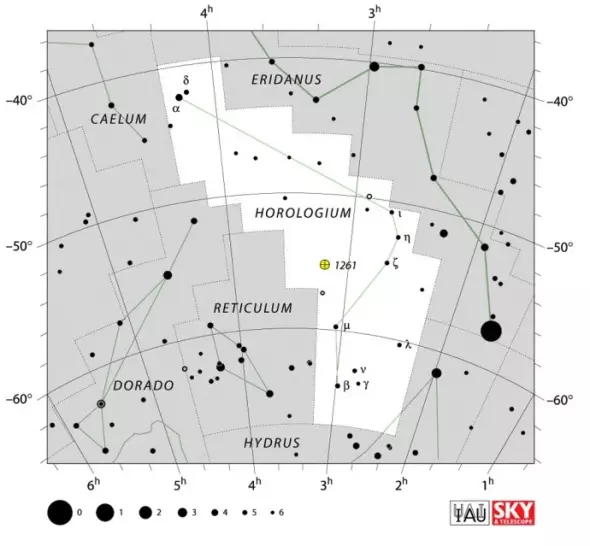
Horologium constellation map by IAU and Sky&Telescope magazine
Story
Lacaille named the constellation after the pendulum clock to honour its inventor Christiaan Huygens. The constellation represents the pendulum clock Lacaille used to time his observations.
The brightest star in the constellation, Alpha Horologii, represents the pendulum in some depictions and marks one of the weights in others.
Horologium stars
α Horologii (Alpha Horologii)
Alpha Horologii is a giant of the spectral type K1III. It has a visual magnitude of 3.86 and is the brightest star in Horologium. It is approximately 117 light years distant from the Sun.
R Horologii (HD 18242)
R Horologii is the second brightest star in the constellation. It is a red giant of the spectral type M7IIIe, approximately 100 light years distant from Earth. It has an apparent magnitude of 4.7.
R Horologii is classified as a Mira variable, which means that it is a pulsating variable red star with a pulsation period over 100 days and light amplitude over one magnitude in infrared and 2.5 magnitude in visual.
The star has a period of 407.6 days and its variations in brightness range from 4.7 to 14.3, which is one of the largest magnitude ranges known.
β Horologii (Beta Horologii)
Beta Horologii is a giant star belonging to the spectral class A4IIIm, approximately 310 light years distant. It is a chemically peculiar star of the metallic-line type, with strong absorption lines of metals. It has an apparent magnitude of 4.979 and is the third brightest star in the constellation.
δ Horologii (Delta Horologii)
Delta Horologii belongs to the spectral class A9V. It has a visual magnitude of 4.93 and is approximately 175 light years distant.
ι Horologii (Iota Horologii)
Iota Horologii is a yellow dwarf of the spectral type G0Vp, about 56 light years distant. It has a visual magnitude of 5.40. It is about twice as luminous as the Sun.
An extrasolar planet the size of Jupiter was discovered orbiting the star in a near Earth orbit in 1998. NASA ranked the star 69th on the list of candidates for the Terrestrial Planet Finder mission before the project was abandoned.
GJ 1061
GJ 1061 is a red dwarf of the spectral type M5.5V, only 11.99 light years distant from Earth. It has a visual magnitude of 13.03. The star has only 11.3% of the Sun’s mass and is 0.1% as luminous. It is the 20th nearest known star system to the Sun.
Deep sky objects in Horologium
Horologium Supercluster
The Horologium Supercluster is a massive supercluster about 550 million light years across and covering an area of 12°x12°. The nearest part is approximately 700 million light years distant from the Sun, and the farthest is about 1.2 billion light years away.
The supercluster contains about 5,000 galaxy groups, which include 30,000 giant galaxies and 300,000 dwarf galaxies. It is also called the Horologium-Reticulum Supercluster.
NGC 1261
NGC 1261 is a globular cluster about 12.9’ in apparent size. It has an estimated age of 10.24 billion years and consists mainly of very faint stars.
The cluster has a visual magnitude of 8.3 and is 53,500 light years distant from the Sun. It was discovered by the Scottish astronomer James Dunlop on September 28, 1826.
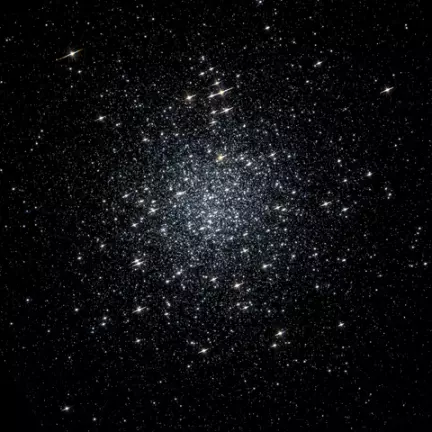
NGC 1261, image based on observations made with the NASA & ESA Hubble Space Telescope, and obtained from the Hubble Legacy Archive, which is a collaboration between the Space Telescope Science Institute, the Space Telescope European Coordinating Facility and the Canadian Astronomy Data Centre.
Arp-Madore 1 (AM1)
Arp-Madore 1 is a globular cluster in Horologium. At a distance of 398,000 light years, it is one of the most remote globular clusters known in the Milky Way’s halo. The cluster has an apparent size of 1.288’ by 0.691’ and an apparent magnitude of 15.72.
AM1 was named after Halton Arp and Barry F. Madore, who used the UK Schmidt Telescope to observe it and identified it as a distant globular cluster in 1979. The cluster had previously been discovered by researchers at the European Southern Observatory.
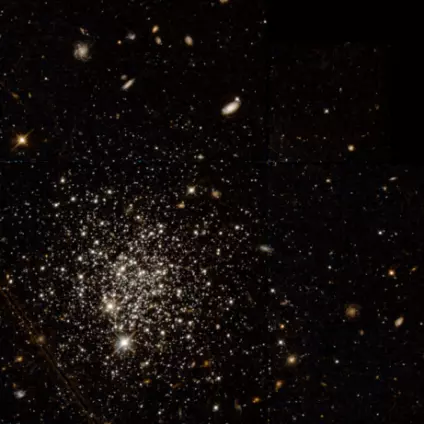
Arp-Madore 1 (AM1), image based on observations made with the NASA/ESA Hubble Space Telescope, and obtained from the Hubble Legacy Archive, which is a collaboration between the Space Telescope Science Institute (STScI/NASA), the Space Telescope European Coordinating Facility (ST-ECF/ESA) and the Canadian Astronomy Data Centre (CADC/NRC/CSA).
NGC 1512
NGC 1512 is a barred spiral galaxy in Horologium. It was discovered by the Scottish astronomer James Dunlop in 1826. It is 8.9’x5.6′ in size and 70,000 light years across, almost as large as the Milky Way.
The galaxy is particularly notable for its starburst ring, composed of young clusters and extending about 2400 light years across. It has an apparent magnitude of 11.1, which makes it bright enough to be observed in amateur telescopes.
The galaxy is about 30 million light years distant from the solar system.
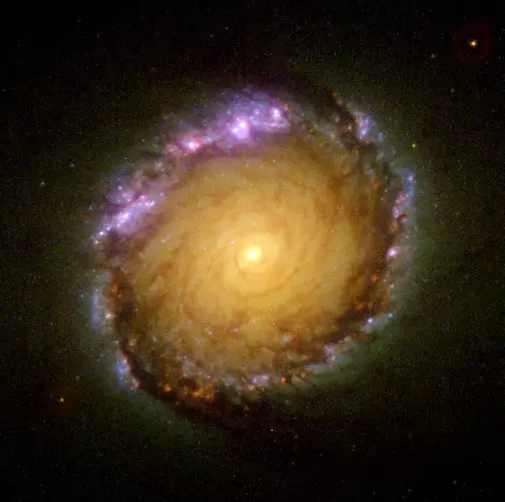
NGC 1512, image: NASA, D. Maoz, A. J. Barth, L. C. Ho, A. Sternberg and A. V. Filippenko
NGC 1510
NGC 1510 is a lenticular galaxy located in the vicinity of NGC 1512. It lies at a distance of about 40 million light years from Earth and has a visual magnitude of 13. The galaxy occupies an area 3.2’ by 1.8’ in size and has a linear diameter of 15,000 light years. It was discovered by John Herschel on December 4, 1836.
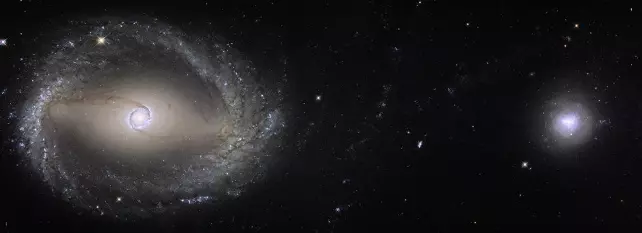
This composite image, created out of two different pointings from Hubble, shows the barred spiral galaxy NGC 1512 (left) and the dwarf galaxy NGC 1510 (right). Both galaxies are about 30 million light-years away from Earth and currently in the process of merging. At the end of this process NGC 1512 will have cannibalised its smaller companion.
NGC 1483
NGC 1483 is a barred spiral galaxy about 40 million light years distant from Earth. It is a member of the Dorado Group, a rich but loose group of galaxies located primarily in the constellation Dorado.
The galaxy was discovered by James Dunlop on September 2, 1826. It has an apparent size of 1.6’ by 1.4’ and an apparent magnitude of 12.3.
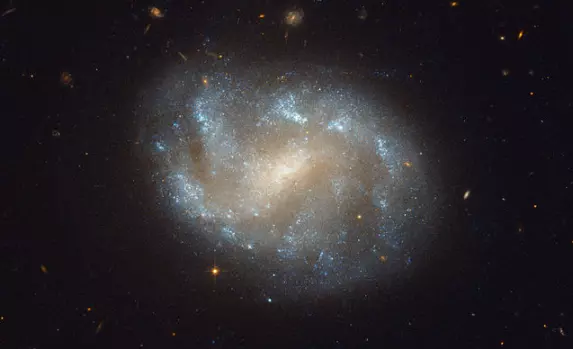
NGC 1483, image: ESA/Hubble & NASA
Miltron’s Galaxy – NGC 1433
NGC 1433 is a barred spiral galaxy notable for its double ring structure and active nucleus. Classified as a Seyfert galaxy, it is the central member of the NGC 1433 Group, a group of galaxies within the larger Dorado Group. It was discovered by James Dunlop in 1826.
NGC 1433 has a visual magnitude of 9.99 and lies at an approximate distance of 32 million light years from the Sun. It has an apparent size of 6.5’ by 5.9’ and a linear size of 60,000 light years. A type II supernova, designated SN 1985P, was observed in the galaxy on October 5, 1985. It had an apparent magnitude of 13.5 at the time of discovery.
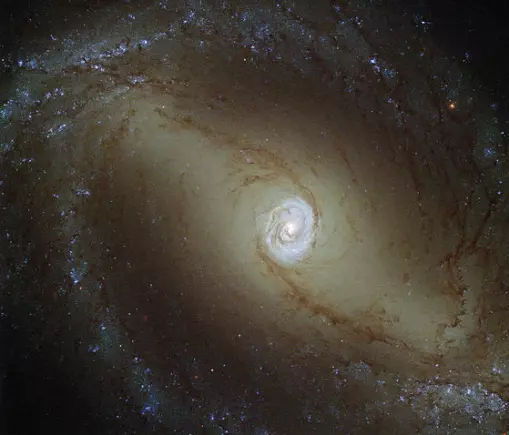
This view, captured by the NASA/ESA Hubble Space Telescope, shows a nearby spiral galaxy known as NGC 1433. At about 32 million light-years from Earth, it is a type of very active galaxy known as a Seyfert galaxy — a classification that accounts for 10% of all galaxies. They have very bright, luminous centres comparable to that of our galaxy, the Milky Way. Galaxy cores are of great interest to astronomers. The centres of most, if not all, galaxies are thought to contain a supermassive black hole, surrounded by a disc of infalling material. NGC 1433 is being studied as part of a survey of 50 nearby galaxies known as the Legacy ExtraGalactic UV Survey (LEGUS). Ultraviolet radiation is observed from galaxies, mainly tracing the most recently formed stars. In Seyfert galaxies, ultraviolet light is also thought to emanate from the accretion discs around their central black holes. Studying these galaxies in the ultraviolet part of the spectrum is incredibly useful to study how the gas is behaving near the black hole. This image was obtained using a mix of ultraviolet, visible, and infrared light. LEGUS will study a full range of properties from a sample of galaxies, including their internal structure. This Hubble survey will provide a unique foundation for future observations with the James Webb Space Telescope (JWST) and the Atacama Large Millimeter/submillimeter Array (ALMA). ALMA has already caught unexpected results relating to the centre of NGC 1433, finding a surprising spiral structure in the molecular gas close to the centre of NGC 1433. The astronomers also found a jet of material flowing away from the black hole, extending for only 150 light-years — the smallest such molecular outflow ever observed in a galaxy beyond our own. Image: ESA/Hubble & NASA Acknowledgements: D. Calzetti (UMass) and the LEGUS Team
NGC 1448
NGC 1448, also catalogued as NGC 1457, is an unbarred spiral galaxy with an apparent magnitude of 10.7, located at a distance of 56.5 million light years from the Sun. The galaxy has an angular size of 7.6’ by 1.7’ and is a member of the NGC 1433 Group. It was discovered by John Herschel on October 24, 1835.
Four supernovae have been observed in the galaxy in recent decades. The type II supernova SN 1983S reached magnitude 14.5 in 1983. SN 2001el was classified as type Ia and also reached magnitude 14.5. Sn 2003hn was another type II supernova, with a peak magnitude of 14.1. In 2014, SN 2014df (14.0 mag.) was observed and classified as type Ib.
In January 2017, researchers announced that they had found evidence for a supermassive black hole in the galaxy.
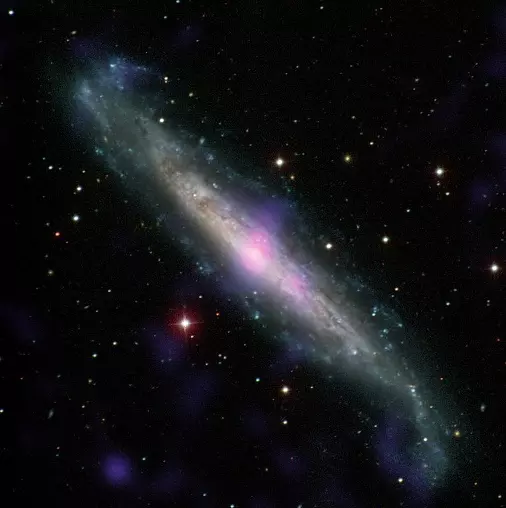
NGC 1448, a galaxy with an active galactic nucleus, is seen in this image combining data from the Carnegie-Irvine Galaxy Survey in the optical range and NuSTAR in the X-ray range. This galaxy contains an example of a supermassive black hole hidden by gas and dust. X-ray emissions from NGC 1448, as seen by NuSTAR and Chandra, suggests for the first time that, like IC 3639 in PIA21087, there must be a thick layer of gas and dust hiding the active black hole in this galaxy from our line of sight. Image: NASA/JPL-Caltech/Carnegie-Irvine Galaxy Survey